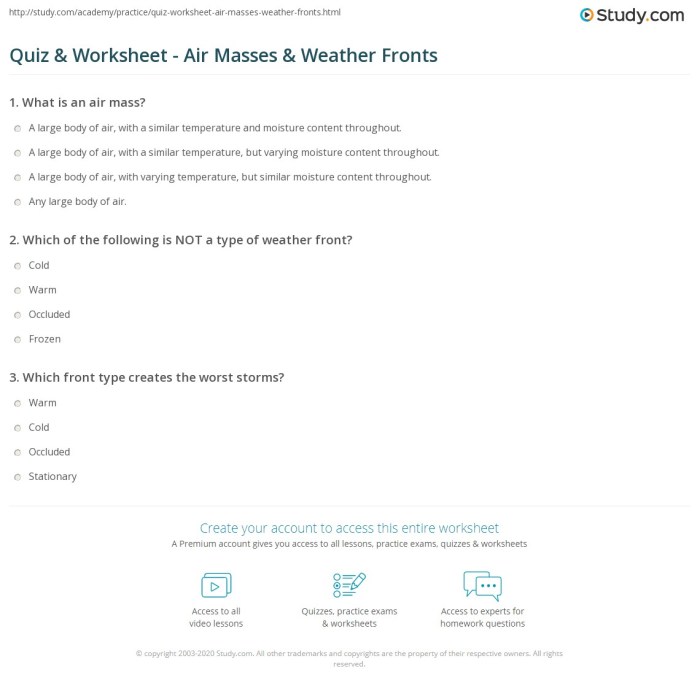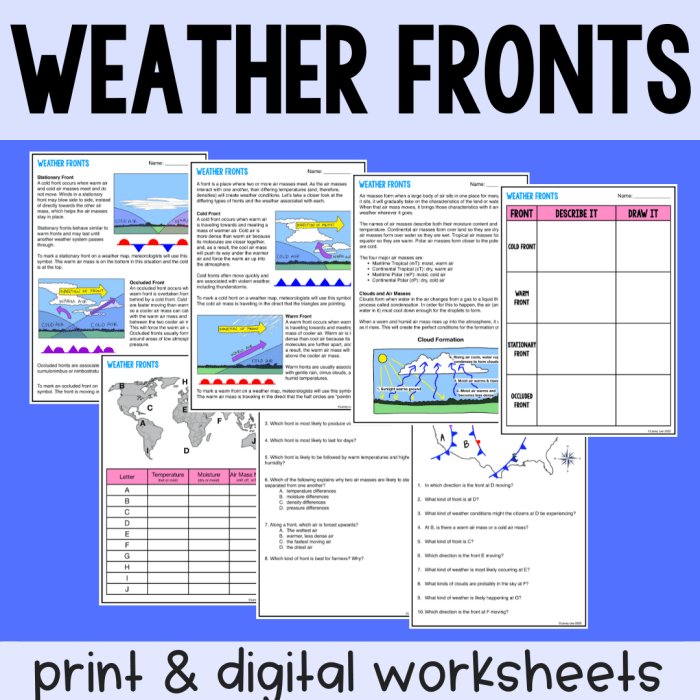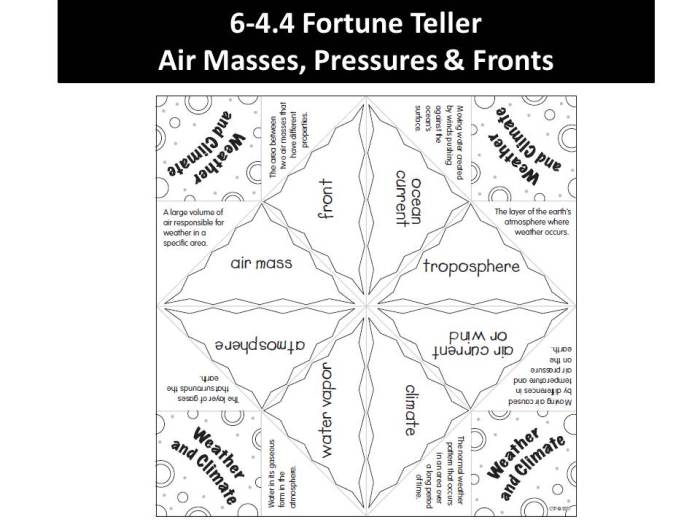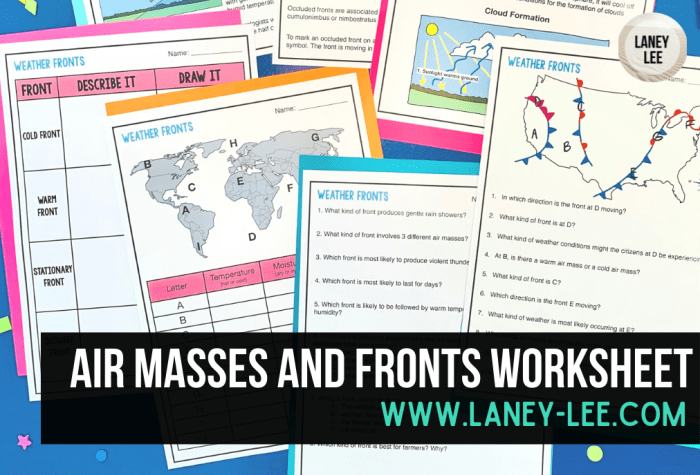Embark on an educational journey with our comprehensive air mass and fronts worksheet, meticulously crafted to provide a captivating overview of these atmospheric phenomena. From defining air masses and fronts to exploring their dynamic interactions, this worksheet serves as a valuable resource for students and weather enthusiasts alike.
As we delve into the intricacies of air masses, you’ll discover their diverse origins and characteristics, shaping the weather patterns we experience. Furthermore, you’ll unravel the secrets of fronts, the boundaries between air masses that bring about dramatic weather changes.
Air Mass

An air mass is a large body of air that has uniform temperature and humidity throughout. Air masses are classified according to their source region, which determines their temperature and humidity characteristics.
Types of Air Masses
There are four main types of air masses:
- Continental polar (cP)air masses originate over high-latitude continental regions and are cold and dry.
- Continental tropical (cT)air masses originate over low-latitude continental regions and are warm and dry.
- Maritime polar (mP)air masses originate over high-latitude ocean regions and are cool and moist.
- Maritime tropical (mT)air masses originate over low-latitude ocean regions and are warm and moist.
The characteristics of each type of air mass are summarized in the table below:
| Air Mass Type | Source Region | Temperature | Humidity |
|---|---|---|---|
| Continental polar (cP) | High-latitude continental regions | Cold | Dry |
| Continental tropical (cT) | Low-latitude continental regions | Warm | Dry |
| Maritime polar (mP) | High-latitude ocean regions | Cool | Moist |
| Maritime tropical (mT) | Low-latitude ocean regions | Warm | Moist |
Fronts

A front is a boundary between two air masses with different temperatures and densities. Fronts are often associated with changes in weather, such as changes in temperature, humidity, and precipitation.
There are four main types of fronts: cold fronts, warm fronts, stationary fronts, and occluded fronts.
Cold Fronts
A cold front is a front that moves in the direction of a warm air mass, replacing it with a colder air mass. Cold fronts are often associated with thunderstorms, squalls, and heavy rain or snow.
Warm Fronts
A warm front is a front that moves in the direction of a cold air mass, replacing it with a warmer air mass. Warm fronts are often associated with clouds, drizzle, and light rain or snow.
Stationary Fronts
A stationary front is a front that does not move. Stationary fronts are often associated with clouds, fog, and drizzle.
Occluded Fronts
An occluded front is a front that forms when a cold front overtakes a warm front. Occluded fronts are often associated with clouds, precipitation, and fog.
Air Mass and Front Interactions: Air Mass And Fronts Worksheet

Air masses are large bodies of air that have similar temperature and moisture characteristics. When air masses of different temperatures and moisture contents meet, they create a front. Fronts are boundaries between air masses, and they can cause a variety of weather conditions.
Types of Fronts
- Cold frontsoccur when a cold air mass moves into a warm air mass. Cold fronts are typically associated with thunderstorms, heavy rain, and gusty winds.
- Warm frontsoccur when a warm air mass moves into a cold air mass. Warm fronts are typically associated with light rain or drizzle, and they can also cause fog.
- Occluded frontsoccur when a cold front overtakes a warm front. Occluded fronts are typically associated with cloudy skies, rain, and snow.
- Stationary frontsoccur when a cold front and a warm front meet and neither one is able to move. Stationary fronts are typically associated with cloudy skies, drizzle, and fog.
Weather Associated with Fronts
The type of weather that occurs when air masses interact with fronts depends on the temperature and moisture content of the air masses involved. Cold fronts are typically associated with severe weather, while warm fronts are typically associated with milder weather.
Occluded fronts can produce a variety of weather conditions, depending on the temperature and moisture content of the air masses involved. Stationary fronts are typically associated with cloudy skies and drizzle.
Air Mass and Front Forecasting
Air masses and fronts are important factors in weather forecasting. By tracking the movement of air masses and fronts, meteorologists can make predictions about the weather in a particular area.There are a variety of weather maps that are used to track air masses and fronts.
These maps include surface weather maps, upper-air charts, and satellite images. Surface weather maps show the location of air masses and fronts at the Earth’s surface. Upper-air charts show the location of air masses and fronts at different levels of the atmosphere.
While the air mass and fronts worksheet might seem like a dry topic, it can actually be quite fascinating, much like the captivating story of a chorus line dancer named Val. In her monologue , Val shares her journey of passion, perseverance, and the struggles she faces in the pursuit of her dreams.
Just as Val’s story inspires us, the air mass and fronts worksheet provides valuable insights into the complex dynamics of our planet’s weather systems.
Satellite images can be used to track the movement of clouds, which can indicate the location of air masses and fronts.
Types of Weather Maps
- Surface weather maps show the location of air masses and fronts at the Earth’s surface.
- Upper-air charts show the location of air masses and fronts at different levels of the atmosphere.
- Satellite images can be used to track the movement of clouds, which can indicate the location of air masses and fronts.
Case Study: Analyze a Weather Map

Let’s analyze a weather map to identify the air masses and fronts present and predict the weather conditions likely to occur.
Consider the weather map provided. It depicts several air masses and fronts influencing the weather patterns in the region.
Air Masses
The map shows the presence of two distinct air masses: a cold air mass (labeled “cA”) and a warm air mass (labeled “wA”). The cold air mass is characterized by lower temperatures and higher pressure, while the warm air mass is characterized by higher temperatures and lower pressure.
Fronts
The map also depicts several fronts separating the different air masses. A cold front (labeled “CF”) is present, separating the cold air mass from the warm air mass. A warm front (labeled “WF”) is also present, separating the warm air mass from another cold air mass to the north.
Weather Conditions, Air mass and fronts worksheet
Based on the air masses and fronts present on the map, we can predict the following weather conditions:
- In the region where the cold air mass (cA) is dominant, cold and dry weather is likely.
- In the region where the warm air mass (wA) is dominant, warm and humid weather is likely.
- Along the cold front (CF), thunderstorms and precipitation are likely.
- Along the warm front (WF), light rain or drizzle is likely.
FAQ Corner
What is an air mass?
An air mass is a large body of air with similar temperature and humidity characteristics that forms over a specific region.
How do fronts form?
Fronts form when two air masses with contrasting temperatures and densities meet, creating a boundary.
What types of weather can occur when air masses interact with fronts?
When air masses interact with fronts, they can produce a variety of weather conditions, including precipitation, thunderstorms, and changes in temperature.